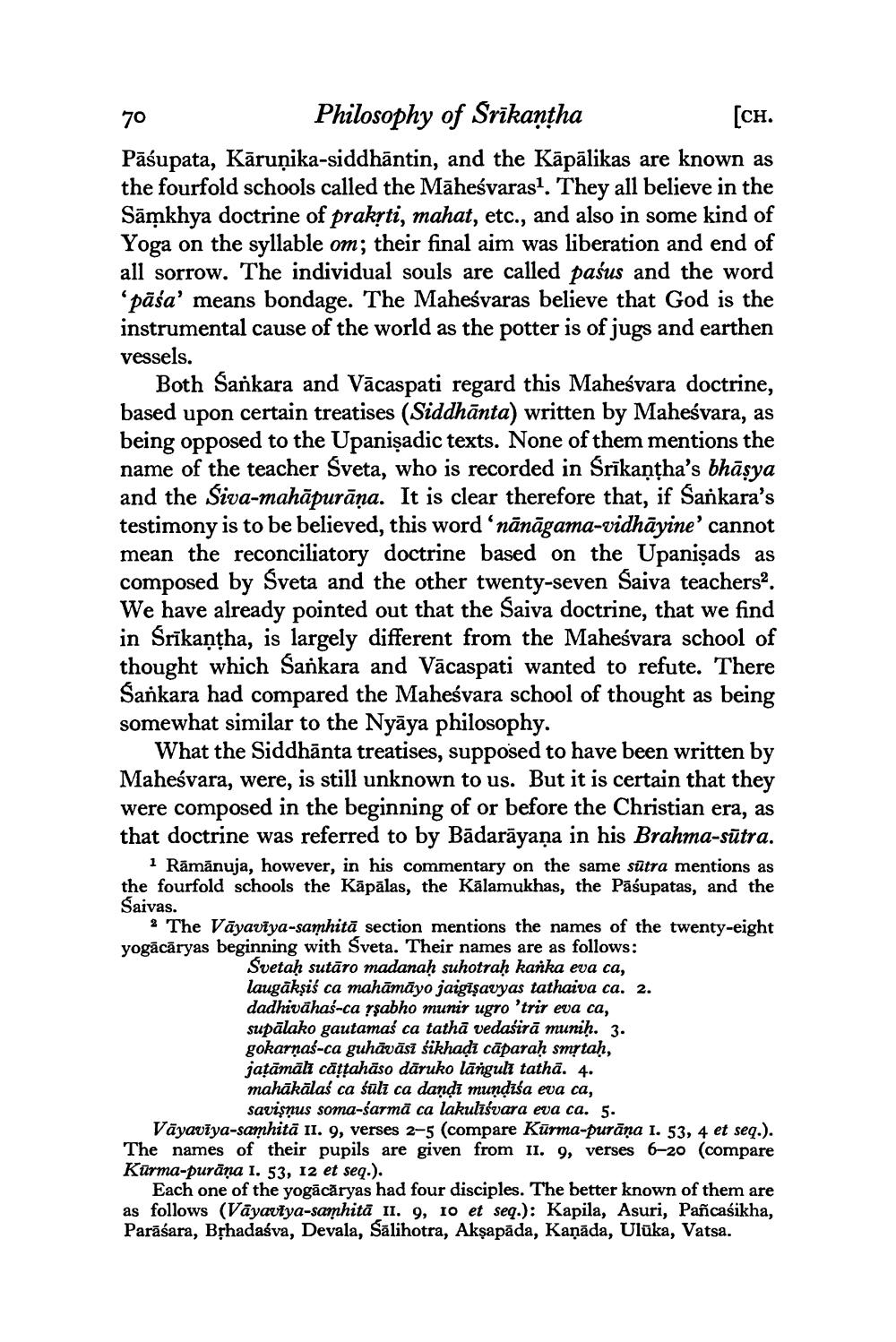________________
70
Philosophy of Srikantha
[CH. Pāśupata, Kāruņika-siddhāntin, and the Kāpālikas are known as the fourfold schools called the Māheśvaras1. They all believe in the Sāņkhya doctrine of prakyti, mahat, etc., and also in some kind of Yoga on the syllable om; their final aim was liberation and end of all sorrow. The individual souls are called pašus and the word 'pāśa' means bondage. The Maheśvaras believe that God is the instrumental cause of the world as the potter is of jugs and earthen vessels.
Both Sankara and Vācaspati regard this Maheśvara doctrine, based upon certain treatises (Siddhānta) written by Maheśvara, as being opposed to the Upanişadic texts. None of them mentions the name of the teacher Sveta, who is recorded in Śrīkaņķha's bhāsya and the Siva-mahāpurāna. It is clear therefore that, if Sankara's testimony is to be believed, this word 'nānāgama-vidhāyine' cannot mean the reconciliatory doctrine based on the Upanişads as composed by Sveta and the other twenty-seven Saiva teachers. We have already pointed out that the Saiva doctrine, that we find in Srīkaņțha, is largely different from the Maheśvara school of thought which Sankara and Vācaspati wanted to refute. There Sankara had compared the Maheśvara school of thought as being somewhat similar to the Nyāya philosophy.
What the Siddhānta treatises, supposed to have been written by Maheśvara, were, is still unknown to us. But it is certain that they were composed in the beginning of or before the Christian era, as that doctrine was referred to by Bādarāyaṇa in his Brahma-sūtra.
1 Rāmānuja, however, in his commentary on the same sūtra mentions as the fourfold schools the Kāpālas, the Kālamukhas, the Pasupatas, and the Saivas.
2 The Vāyaviya-samhitā section mentions the names of the twenty-eight yogācāryas beginning with Sveta. Their names are as follows:
Svetah sutāro madanaḥ suhotrah kanka eva ca, laugākşiś ca mahāmāyo jaigīşavyas tathaiva ca. 2. dadhivāhas-ca rsabho munir ugro 'trir eva ca, supālako gautamaś ca tathā vedasirā munih. 3. gokarnas-ca guhāvāsi śikhadi căparaḥ smştah, jatāmālı căttahäso dāruko lāngul tathā. 4. mahākālaś ca suli ca dandi mundiśa eva ca,
savişnus soma-sarmā ca lakulīśvara eva ca. 5. Vāyaviya-samhitā ll. 9, verses 2-5 (compare Kurma-purāna I. 53, 4 et seq.). The names of their pupils are given from II. 9, verses 6-20 (compare Kūrma-purāna I. 53, 12 et seq.).
Each one of the yogācăryas had four disciples. The better known of them are as follows (Vāyaviya-samhitā 11. 9, 10 et seq.): Kapila, Asuri, Pañcaśikha, Parāśara, Bșhadaśva, Devala, Salihotra, Akşapāda, Kaņāda, Ulūka, Vatsa.




